Team-Building with “Yes, And…”

Teams with a collaborative culture build on their members’ ideas to create innovation. Actors use improvisation (improv) techniques in the theater to limber up and hone their creative edge as they ease into their scripted roles. These exercises build trust within an ensemble and help participants generate creative ideas. Professional improvisers perform scenarios live on stage based on the spontaneous input of their audience, pulling a scene together on the fly. It’s unscripted, like life. Adapting classic improv techniques can help your team build agility, boost communication skills, creativity and fearlessness. Ready to roll up your sleeves?
Today’s most innovative companies are the ones that have successfully implemented the improvisational approach.
Keith Sawyer
In Group Genius, author Keith Sawyer urges readers to reject the idea of the lone creative genius as a myth. Innovation depends upon interaction, even if it’s just because good ideas are often built atop the original half-baked ones. “Invisible collaborative webs” are most often responsible for breakthroughs. Take mountain bikes. Their design evolved from different enthusiasts coming up with modifications, like fatter tires and additional gears, that better adapted the bicycle for mountainous terrain – an addition here, a tweak there, until now there is a distinct mountain bike category.
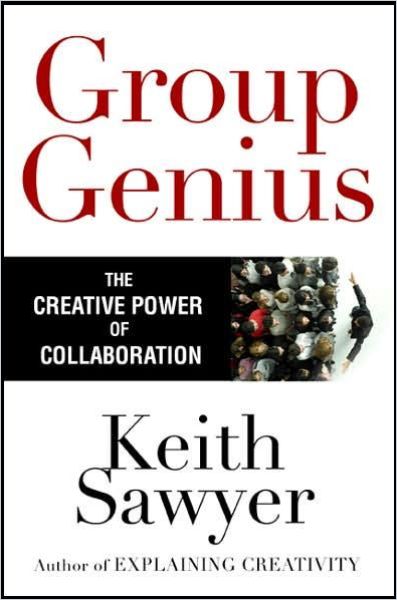
Similarly, jazz bassist and software development manager for IBM Adrian Cho writes in The Jazz Process that jazz musicians riff off each other’s contribution to spontaneously create a new way of playing jazz standards. The goal of the process is to reduce friction and build creative momentum. The strongest, most resilient and creative teams are the most diverse; these expose all members to various perspectives.
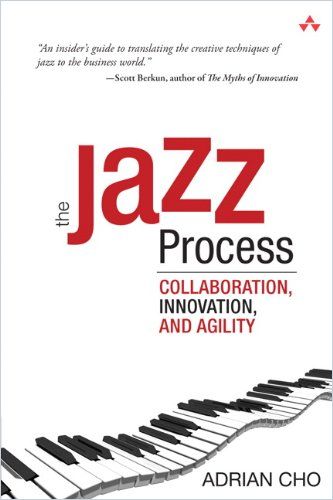
Jazz is democratic. Jazz is genuine. Jazz is joyful and at times soulful. Jazz is all of these things. However, it’s not just the end result that’s interesting but the process of making the music.
Adrian Cho
Top firms like Nissan and Google send their executives to Second City, a world-renowned improvisation theater troupe, to learn their techniques. Improv exercises are useful in business for building team coherence and flexibility, all while injecting humor into what can, at least at first, feel like an awkward situation. Business leaders can use improv techniques for organizational development, during workshops or as a team exercise.
Be Completely Present
Author Robert Lowe is a theater professional who brings the limbering practices of improv to organizational settings. In Improvisation Inc., he shows how adopting improv lessons loosens up bureaucracies and rigid thinking patterns. The first rule of improv is to be mindful, open all your senses, to let go of past and future worries and be completely aware of the present moment. Check out Sara Kupfer’s interview with psychologist Audrey Tang for ways to build mindfulness into your day.

Go into an improv exercise with no fixed end or solution in mind. Think about the past for a few minutes – past hours, days, months, years – then let those thoughts go. Do the same for your future. Now you’re ready to explore the present moment with all of your sense open.
To fully embrace ‘Yes, and…’ and make fast, effective decisions in the real-world environment, we have to do something counterintuitive: slow our brain down.
Bob Kulhan and Chuck Crisafulli
Listen Without Judgment
Actively listening is fundamental to building empathy and trust between team members. As you open yourself to the present moment, get into a receptive, nonjudgmental mode. A primary goal of improv is to improve communications between people. Be mindful of your use of language and the way you feel. How do they align? How do they diverge? Use improv-based exercises to recognize patterns at work and to explore fears. To do this requires a willingness to be honest with yourself and with your colleagues. You must be willing to be vulnerable. Improv games with two people will feel most risky. Avoid that by pairing everybody in a group.
Improvisation provides a mechanism by which we can practice challenging our patterns without breaking the machinery. It provides a system with which we can practice handling change in positive and effective ways.
Robert Lowe
An opening exercise that loosens people up such as bouncing an imaginary ball between participants or sending teams on a scavenger hunt helps to build rapport. Build communication and playfulness with the “word for word” game, where participants answer a question, each one offering one word of the answer in sequence. Assign an emotion to four sections of a divided square and invite participants to carry on a conversation expressing the emotion in their area. But it all starts with listening closely.

Yes, And…
In improv, members accept teammates’ ideas without judgement. Instead of saying, “yes, but” or “no,” they say “yes and,” leaving room for further discovery. That “yes” builds an environment of safety and support necessary to overcome fear and generate truly spontaneous creativity. When you say “yes, and…” you accept another’s idea and build upon it.
Professional improvisers prepare themselves to be open and receptive, but, at the same time, they enter the performance space with an idea in mind of both their audience and what they hope to accomplish. In Happy Accidents, improv performers David Ahearn, Frank Ford and David Wilk describe how they developed their “group mind” to the point where they sense what other team members might do next even though they can’t predict what the scenario might be ahead of their performance. They encourage each other to push beyond personal boundaries. They think of their troupe like a baseball team and don’t care who on the team actually “scores,” only that their shows are great.

“Yes, and” people…literally change the face of the world with the simple belief that anything is possible.
David Ahearn, Frank Ford and David Wilk
Use improv principles to enhance brainstorming sessions. Remove all distractions: cell phones off. Begin with an exercise to increase awareness in the present moment. Remember to actively listen to what others say. Sometimes, changing the environment can help stimulate creative ideas. Rearrange conference room space to let team members interact more freely. Remind everyone about the principles of “yes, and…” and to refrain from judging the ideas of others. Editing ideas comes later. Start with a problem or a challenge and let the ideas flow, generating as many as possible. To demonstrate that failure is encouraged, the leader can throw out some truly terrible ideas to put others at ease. Sift through the ideas for the specks of gold within them. You’ll only accumulate these specks of gold if team members feel that contributing even wacky ideas is safe.
Improvisation is not…the creation of something out of nothing as much as it is the creation of something out of everything – everything one has been taught, everything one has experienced, everything one knows.
Bob Kulhan and Chuck Crisafulli
Rotating Leadership
In Getting to Yes And…, authors Bob Kulhan and Chuck Crisafulli emphasize that in improv, team members follow each other’s leads; no one is the leader all the time. Improv accepts that an ensemble team will create better solutions together than any one person would alone. In a business context, leaders who focus on listening and building ensemble rapport rather than asserting their authority will get the best results. Build the integrity of the group. See yourself as a “leader of leaders.” Let different people lead when the team needs their expertise. Use improv techniques to help break down barriers between silos.
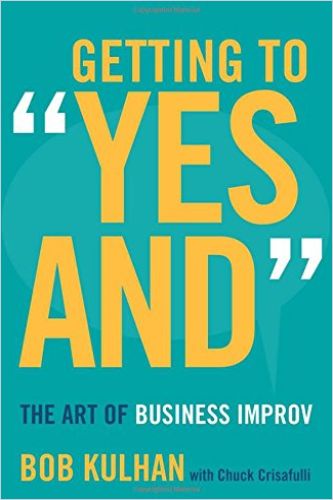
Even though there’s no ‘leader’ on an improv stage, the same skills and mind-set that make an excellent improviser make for an excellent leader in the business setting.
Bob Kulhan and Chuck Crisafulli
Embrace Fails
The executive vice president of Second City Inc., Kelly Leonard and the CEO of Second City Works, Tom Yorton, steeped as they are in the traditions of one of the most famous improv troupes in the world, Second City, literally wrote the book on translating improv techniques to a corporate setting. In Yes, And…, they build upon the “yes, and…” principle, emphasizing that the best improv is a “co-creation” which in turn relies on absolute candor.
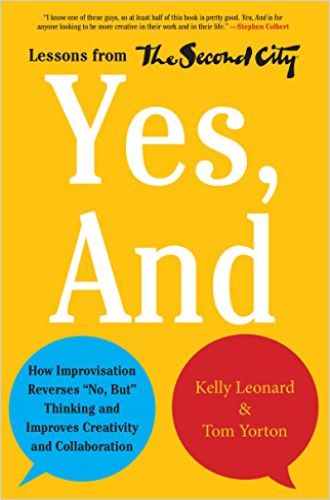
Errors are a fact of life. Everyone makes mistakes. Therefore, embrace failure. Incorporate failure into your narrative and keep going. Taking the fear out of failure encourages bolder thinking and risk-taking with big potential. Creative cultures encourage colleagues to “question the status quo.” Respect is the watchword, but beware of reverence, which strangles creativity.
The…organization that takes itself too seriously and doesn’t know how to question its own beliefs is at a strong competitive disadvantage.
Kelly Leonard and Tom Yorton
“Give and Take”
In Second City history, some superstars, like John Belushi and Bill Murray, always commanded the spotlight, even when they didn’t try to. They were naturally “takers.” But the ideal ensemble member is able to both give and take. If everyone gives up needing his or her idea to be the best or the only idea, generating creative solutions to problems will happen with greater fluidity.
Improv games have rules, just as the games you played as a child did. Try these team-building exercises from the world of improv:
- “Talk Without I” – Form groups into pairs. Each pair discusses whatever topic they like but neither says the word “I.” Afterwards, discuss the ways not saying “I” helped people share ideas.
- “Mirror” – Working in pairs, one person moves his or her body or face and the other person mimics the action. Each person gets the chance to lead.
- “Emotional Option” – People talk in pairs and then the group’s leader will shout out an emotion, for instance, “frustration.” Then group members talk in “the tone of that emotion.” This builds emotional openness.
- “String of Pearls” – All members stand shoulder to shoulder in a line. The group leader tells the first person and the last person in the line a sentence that forms the beginning and end of a story. For instance, it may start “I went to the doctor today” and end with “Then my candy bar talked to me.” Every person in between comes up with a sentence to move that story along in a “logical” way. The goal is to listen carefully and to employ imagination to achieve a group goal.
Beware the Downsides
Adrian Cho reminds readers that the elements of fruitful and creative collaboration come with potential downsides. Keep rules simple and few. Emphasize team effort but don’t smother individual talent. Momentum in the wrong direction will undermine your goals.
Build on these team skills with role-playing exercises and developing possible future scenarios for your business. In their book The People Equation, Deborah Perry Piscione and David Crawley recommend implementing a “Improvisational Innovation Process” that formalizes capturing and testing ideas generated by anyone within an organization. This gives workers confidence that the best ideas will be heard and acted upon no matter where they come from.
Scenario thinking enables businesses to avoid conventional approaches that may be easily predicted and parried by a competitor, allowing new business ideas to be invented instead.
Kees Van Der Heijden , Ron Bradfield , George Burt , George Cairns and George Wright
In The Creativity Leap, author and creativity strategist Natalie Nixon bundles improvisation with inquiry and intuition, all guided by organizational analytics to continuously develop innovation.
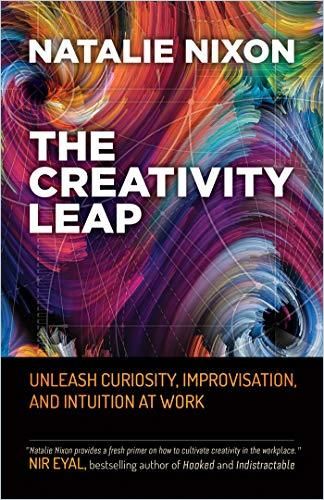
Collaboration doesn’t come from a bunch of meetings. True collaboration and creative synergy comes through our ability to improvise with one another.
Natalie Nixon
In 3 Words for Getting Unstuck, performance coach Travis L. Thomas humorously lays out the ways to incorporate the “yes, and…” philosophy into your life. Just like caterpillars go through a messy transformation before becoming a butterfly, so too should you “embrace the goo” of challenges that take you out of your comfort zone and realize the best answer to “how?” is “yes!”
For more ideas on team-building and creative culture:





